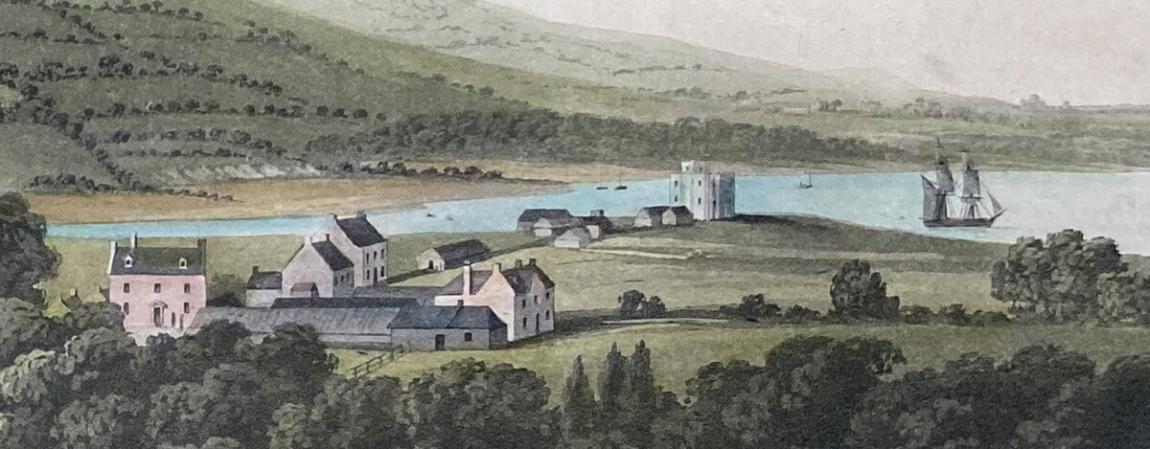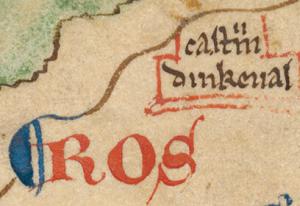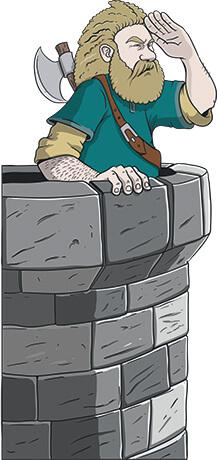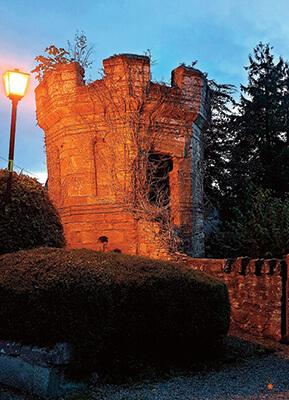
Protection for a frontier town

The position of Dingwall played a strategic role sitting between two significant crossing points: north across the marshy estuary of the Peffery and east across the River Conon, along which people travelled through the mountains to the west-coast sea lochs and the Hebrides, which even in the 13th century were still within the Norwegian kingdom. Dingwall was thus a frontier town.
In the 11th Century it is very likely that the Norse colonists would have protected their interests in the area with a stronghold, perhaps a wooden palisaded fort, and perhaps here on a semi-peninsula into the marshes of the Peffery's outflow, close to the pool area where their ships would be beached for loading, offloading and repair.
When the Norse influence lessened the strategic position was unchanged and a royal castle was key. Castrum Dinkeual appears on a 1250 map so was probably the stone-built replacement for the old motte, and erected by Fearchar mac an t-Sagairt, the first Earl of Ross.
The Castle and the Royal Burgh

King Alexander II had made Fearchar an Earl in 1226, as an appreciation of his strength in controlling the area and his political nous in capturing and beheading the last MacWilliam rebels against the current king's authority. In the same year Alexander strengthened his own royal authority by introducing checks and balances by making Dingwall a royal burgh but while also retaining the central Moothill as a royal point of power.
For 250 years Dingwall was held by the Earls of Ross. They had wide lands and wide authority. Fearchar married his daughter Christian to a contender for the Manx throne: Olaf the Black, half brother of Rognvald, fought with his nephew in Lewis and Skye but won out and he and his Rognvald shared the Kingdom of Mann. Olaf died in 1237.
Subsequent generations of the Earls of Ross added their own stories to the castle's history. Fearchar's son William I added Lewis and Skye to the portfolio. His son William II figured in the Wars of Independence with a balancing act that supported different sides including blotting his copybook with Robert Bruce in 1306 when he violated the sanctuary of St Duthac's chapel in Tain to capture the Bruce's wife and daughter sheltering there. After holding them in Dingwall Castle he handed them over to the English where they were caged and ill-treated until after Bannockburn. William and Robert were reconciled and William signed the Declaration of Arbroath.
William's son Hugh married King Robert's sister and died at the Battle of Halidon Hill in 1333. His son William III was cousin to David II of Scots and rose and fell in their relationship. During his time the Black Death came to Dingwall with what wider effects we cannot be certain
until 1476 when the Earldom was surrendered to the Crown and the lands were placed under the control of the Chief of the Mackenzies and the Munro Barons of Foulis. Under Royal control Dingwall Castle resumed its strategic function and was stocked with weaponry and provisions for a garrison of 60 men-at-arms. There were royal visits to Dingwall Castle by James IV in 1493 and 1503 and later by Queen Mary.

A castle no more!
By the end of James VI’s reign the castle was no longer needed and was allowed to go to ruin helped by the Burgh’s people who recycled its stones to build houses for themselves. The Castle was finally levelled in 1818 when the canal was built, leaving but a single fragment to mark where a castle had been.
Castle House was built on the site in 1822 by Captain Donald MacLennan, merchant seaman and native of Dingwall, who returned home a wealthy man after thirty years trading around the world and it has been a private residence ever since.
Further reading
Norman MacRae: Romance of a Royal Burgh; Dingwall's Thousand Years (1923, reprinted 1974)
David Kyle Cochrane-Yu: A Keystone of Contention:The Earldom of Ross 1215-1517 (PhD thesis 2016)
Major Harmon Pumpelly Read: Rossiana [descendants of the Earls of Ross in Scotland] (1908)
Francis Nevile Reid: The Earls of Ross and their Descendants (1894)
Panel sponsored by the Highland Society of London
Do you know something we don't?
Please contact us if you spot an error here or on the panel, or if you have a suggestion for improving the information using »»» this form.

Once you have enjoyed your walk and learning more about Dingwall, you can donate between £1 and £20 by text towards the maintenance and development of the Heritage Trail.
Text DINGWALL to 70450 to give £3.
To donate any other value, add the digit/s: e.g. DINGWALL5 gives £5, DINGWALL12, £12. We, along with over 5500 charities across the UK, trust DONR to collect donations securely.
